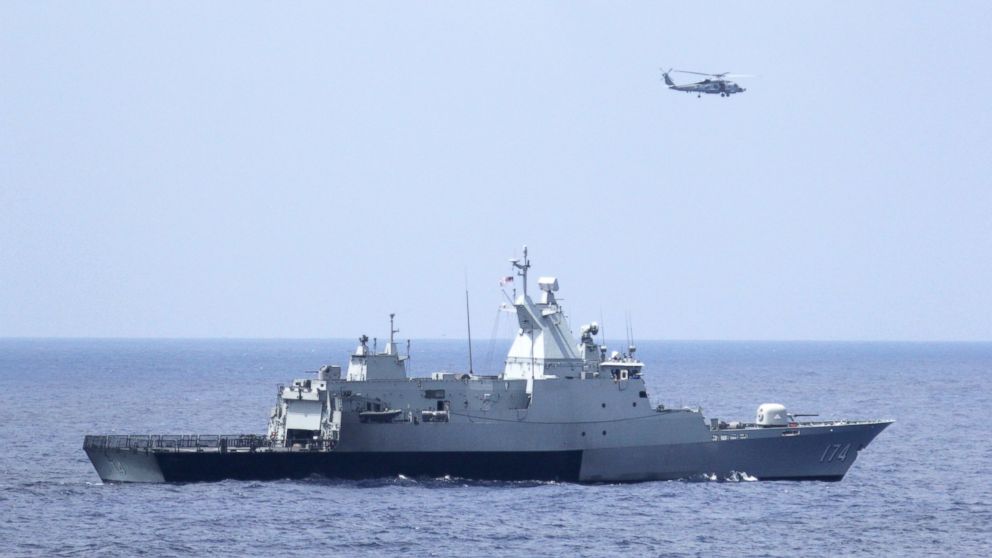Malaysia Airliner Communications Shut Down Separately, US Officials Say
March 13, 2014— -- Two U.S. officials tell ABC News the U.S. believes that the shutdown of two communication systems happened separately on Malaysia Airlines Flight 370. One source said this indicates the plane did not come out of the sky because of a catastrophic failure.
The data reporting system, they believe, was shut down at 1:07 a.m. The transponder -- which transmits location and altitude -- shut down at 1:21 a.m.
This indicates it may well have been a deliberate act, ABC News aviation consultant John Nance said.
U.S. investigators told ABC News that the two modes of communication were "systematically shut down."
That means the U.S. team "is convinced that there was manual intervention," a source said, which means it was likely not an accident or catastrophic malfunction that took the plane out of the sky.
U.S. officials said earlier that they have an "indication" the missing Malaysia Airlines jetliner may have crashed in the Indian Ocean and is moving the USS Kidd to the area to begin searching.
It's not clear what the indication was, but senior administration officials told ABC News the missing Malaysian flight continued to "ping" a satellite on an hourly basis after it lost contact with radar. The Boeing 777 jetliners are equipped with what is called the Airplane Health Management system in which they ping a satellite every hour. The number of pings would indicate how long the plane stayed aloft.
It's not clear, however, whether the satellite pings also indicate the plane's location.
The new information has greatly expanded the potential search area into the Indian Ocean.
"We have an indication the plane went down in the Indian Ocean," the senior Pentagon official said.
The official initially said there were indications that the plane flew four or five hours after disappearing from radar and that they believe it went into the water. Officials later said the plane likely did not fly four or five hours, but did not specify how long it may have been airborne.
White House spokesman Jay Carney said, “It's my understanding that based on some new information that's not necessarily conclusive, but new information, an additional search area may be opened in the Indian Ocean, and we are consulting with international partners about the appropriate assets to deploy.”
Carney did not specify the nature of the “new information.”
Pentagon officials said that the destroyer USS Kidd was being moved to the western part of the strait of Malacca at the request of Malaysia and is heading towards an area where the Indian Ocean and the Andaman Sea meet. The ship has helicopters aboard that can scour the area.
The U.S. action came hours after Malaysian officials said they had extended their search into the Andaman Sea and had requested help from India in the search for the missing plane and its 239 passengers.
Investigators also said today that U.S. officials gave them reasons to keep searching the waters west of Malaysia, far from the flight path of the Malaysia Airlines plane.
Malaysian Defense Minister Hishammuddin Hussein said that the search’s “main focus has always been in the South China Sea,” which is east of Malaysia and along the plane’s route from Kuala Lumpur to Beijing.
But the search was extended earlier this week to include water far to the west on the other side of Malaysia.
“We are working very closely with the FAA and the NTSB on the issue of a possible air turn back,” Hishammuddin said, referring to the U.S. Federal Aviation Administration and National Transportation Safety Board.
“They have indicated to us that based on the information given by the Malaysian authorities, they — being the FAA and NTSB — the U.S. team was of the view that there was reasonable ground for the Malaysian authorities to deploy resources to conduct search on the western side of the peninsula of Malaysia. Under the circumstances, it is appropriate to conduct the search even if the evidence suggests there is a possibility of finding a minor evidence to suggest that ... the aircraft would have been there.”
Hishammuddin said it was possible the plane kept flying after dropping off of radar. "Of course, this is why we have extended the search," he said.
The Malaysians spent much of today's news conference dismissing earlier leads.




